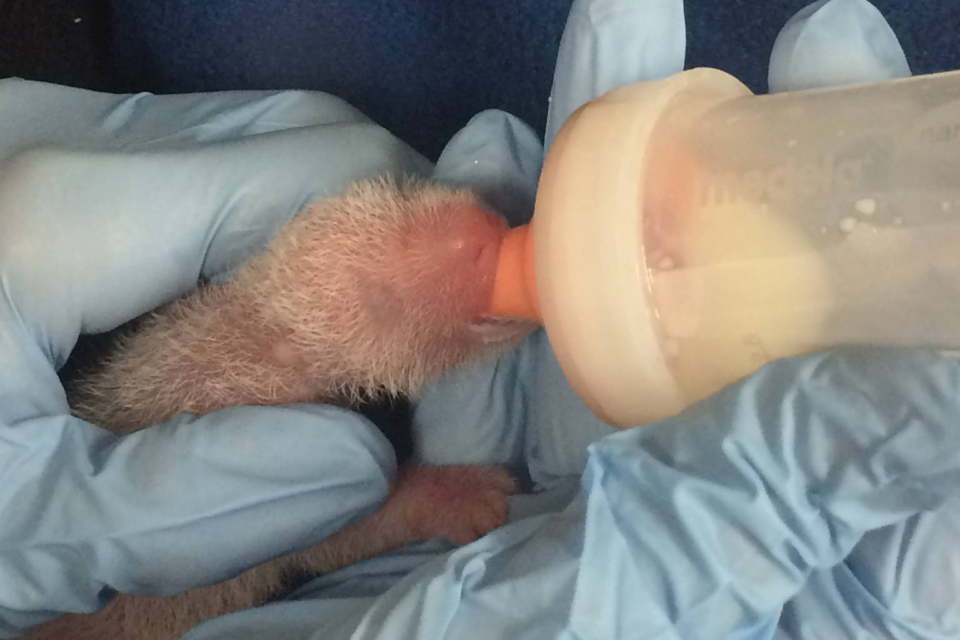The U.S. Smithsonian’s National Zoo said that the smaller of the two newborn panda cubs died shortly after 2 p.m. on Wednesday. The tiny cub had been getting extra care at the zoo after mother Mei Xiang stopped letting animal keepers swap the smaller cub in for feedings as she cares for the larger twin, the zoo said Tuesday.

The smaller cub was with Mei Xiang from about 2 p.m. on Tuesday until Wednesday morning. When the panda team swapped the cubs this morning, they assessed the little cub and had concerns because it had not increased in weight, appeared weaker, and exhibited possible respiratory issues.
Mei Xiang has the larger cub in her possession and appears to be taking good care of it, the zoo said. The larger cub appears strong and robust and is urinating and defecating normally. At last weigh-in, the cub was 137.7 grams, the zoo said.
At the birth of the second cub, Mei Xiang demonstrated that she was challenged to care for both cubs, but she did not indicate a preference for one cub over the other. the zoo said.

Zookeeper Shellie Pick cares for the smaller panda cub in an incubator overnight at the Smithsonian’s National Zoo, Aug. 24. Here she is weighing the cub, stimulating it to go to the bathroom, and taking its temperature. (Photo: Smithsonian National Zoo)
“The collective scientific knowledge about giant panda mothers is that they are best able to care for one cub at a time,” the zoo said in a statement.
Zoo officials had said the smaller cub’s behaviors were good, but the team was concerned about the cub’s fluctuating weight. Keepers had bottle- and tube-fed the smaller cub and because it had shown some signs of regurgitation, which can lead to aspiration, they also administered antibiotics to prevent possible infection.
To keep the smaller cub hydrated, the zoo had alternated an infant electrolyte solution with formula and administered fluids under the skin. The smaller cub was urinating and defecating well, but on Wednesday morning, staff said it was weaker and struggling to breathe.
“Despite the extreme efforts of our dedicated staff, we weren’t able to change things,” Don Neiffer, chief veterinarian at the zoo said.
Because pandas won’t usually nurse twins if left to their own devices, per the Giant Panda Twin Hand-Rearing protocol, officials tried to switch the cubs every four hours to allow the mother to nurse and bond with one cub at a time while the other was bottle fed and kept warm in an incubator. The cub-swapping approach the panda team used to care for the twin cubs was developed by Chinese colleagues during the past 15 years.
Mei Xiang stopped allowing the cub swap Monday afternoon.
The smaller cub had weighed 86 grams at birth, and the larger cub weighed 138 grams. According to the zoo, bear cubs have the smallest infant-to-mother size ratio of any placental mammals at about 1 to 700. Mei Xiang currently weighs about 238 pounds (108 kilograms), making the smaller cub’s infant-to-mother ratio 1 to 1,256 and the larger cub 1 to 783.
READ MORE PANDA COVERAGE ON CCTV AMERICA
Additional veterinarian staff members had been brought in to assist from the Smithsonian Conservation Biology Institute in Front Royal, Virginia, along with an additional panda keeper from Zoo Atlanta to work with the team in Washington.
The Zoo’s pathologists will perform a necropsy (animal autopsy) on the cub and a final report will be made in the next few weeks.
At the time of death, the cub weighed 79.8 grams, about 2.8 ounces. The mortality rate for panda cubs in their first year in human care is 26 percent for males and 20 percent for females.
Giant pandas give birth to twins approximately 50 percent of the time. This is only the third time a giant panda living in the United States has given birth to twins.
Story compiled with information from the Associated Press and the National Zoo.
Watch Mei Xiang on the zoo’s live pandacam:
 CGTN America
CGTN America

